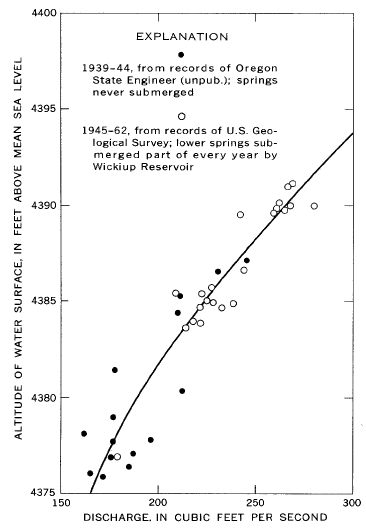From figure 11, the spring flow is about 190 cfs for a lake level of 4,380 feet and 280 cfs for a lake level of 4,391 feet. These flows are believed to represent maximum possible rates of seepage from Davis Lake. The actual rates lie somewhere between 55 and 190 cfs for the 4,380-foot level and between 104 and 290 cfs for the 4,391-foot level. The average flow of Davis Creek is about 220 cfs. On the basis of the relative size of drainage areas, both the average inflow and the average seepage loss at Davis Lake are estimated at 150 cfs.
The relationship of lake level to spring flow shown in figure 11 has been used to estimate the stage (4,392.5 ft) corresponding to a discharge measurement of 287 cfs on Davis Creek made September 12, 1904, the highest measured flow of Davis Creek. That level exceeds any of record .for the month of September.
The relationship between the water level of Davis Lake and the unsubmerged flow of all the springs feeding Davis Creek has apparently not been changed by the operation of Wickiup Reservoir. Periodic submergence of the lower springs may temporarily reduce their outflow, either by diverting a part of it to higher outlets or by inducing temporary ground-water storage. However, flow measurements of Davis Creek made after the reservoir level has been lowered below the level of the lower spring outlets agree well with those made before those springs were submerged.
 |
| Figure 11.-Relation of stage of Davis Lake to simultaneous flow of Davis Creek below springs, in SE/4 sec. 5, T. 22 S., R. 8 E. |
***previous*** — ***next***

